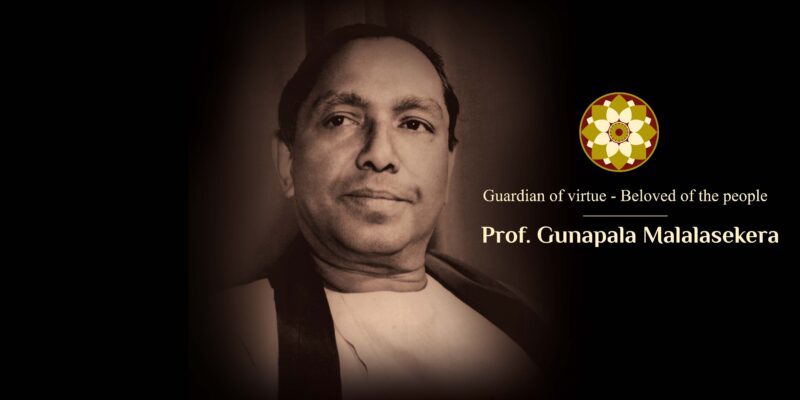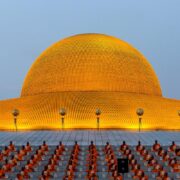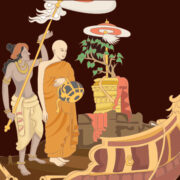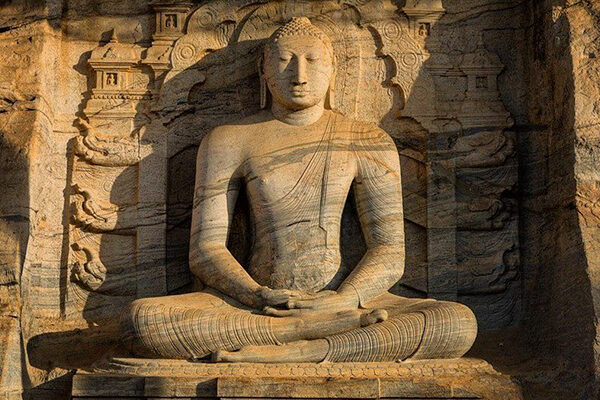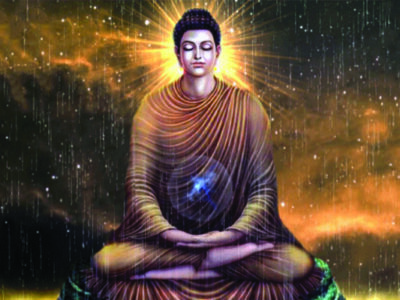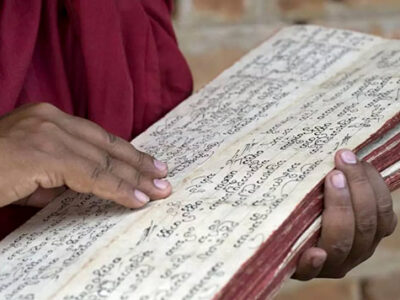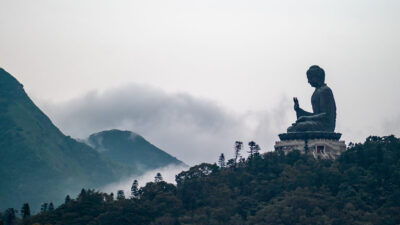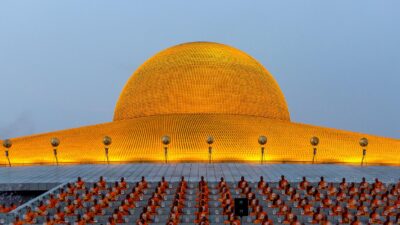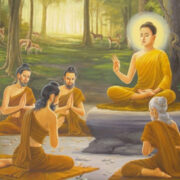By Rev, Wetara Mahinda
(The writer was former Head, Department of Archaeology, University of Peradeniya, Peradeniya, Sri Lanka and a resident monk attached to the Metta Meditation Center, Janesville, MN, USA. He currently lives in Colombo.)
Professor Gunapala Malalasekera’ s (hereafter GPM simply to save the space here but not at all to underestimate his remarkable character) birth anniversary falls on November 9th and, in this article, I am trying to do my best, as a tribute to this genius, to highlight only some aspects of his invaluable and inexplicable services to the society of Sri Lanka and the Buddhist world in numerous capacities.
Having been born in Malamulla, Panadura, and having been educated primarily by his physician-father and by the teachers at St John’s School, GPM was compelled by the circumstances to learn during the school days itself the reality of the tremendous hardships the people underwent in this country and the necessity for reshaping the national education system. The contemporary role played by the organizations like the All Ceylon Buddhist Congress was enormously significant in creating the enthusiasm in him for the teaching career within the Buddhist school system primarily, introduced by Colonel H. S. Olcott and others and secondarily, developed by F. L. Woodward and P. de S. Kularatne. Ananda College, established on November 1, 1886 by Olcott and headed by P. de S. Kularatne became the birthplace for his making active of his pragmatic ideals associated with Buddhist ideals. Ananda College was fortunate to receive fully the services of the magnificent and dynamic leader in the caliber of GPM with effect from 1921. He, later, served there as Vice-Principal from 1922 and in 1923, was appointed Acting Principal. The same year he left the island for postgraduate study and after completion of it in London, became the first registered principal of newly established Nalanda College in 1926. In addition to serving at these schools, the help provided by him to establish many other educational institutes in the island and in this way his service to uplift the education in schools in the entire country was enormous and highly praiseworthy.
While serving Nalanda, he was invited to the Ceylon University College as a lecturer in Pali, Sinhala and Sanskrit in 1927. The decision for resignation from the school was a terribly difficult task for him but, though unwillingly, he bid farewell to it for accepting the newly offered role in the university career. Later, in 1939 he was Professor in the three disciplines mentioned above in the College. Having been, later on, appointed as Professor in Pali and Buddhist Civilization and also as the Dean of the Faculty of Oriental Studies of the University College in 1942 he was able to broaden his horizons in the higher education sector in an unprecedented manner. From then onward GPM carried out his teaching, research and administrative work both at Colombo and Peradeniya until 1957 when he was appointed as Ambassador to the USSR, a newly created diplomatic relationship. After ten years, the role he played vigorously in the diplomatic circle ended up with his accepting the newly offered job as the Chairman of the National Commission of Higher Education, NCHE in Colombo in 1967.
When he was initially invited for the post of Chairman of NCHE in 1965 he convened his desire to accept it by saying “I miss Ceylon so much and I would gladly spend my last years doing what little I can for it.” writes Dr Ananda Guruge in his reminiscences on GPM. Guruge also recollects the way the rich diversity of themes discussed on the development of Higher Education at the initial level itself. At the informal meeting held with the Education Minister on 29. 9. 1966, GPM, as the Chairman agreed with him that country’s universities should aim at not merely making men and women learned people but also useful citizens. While in duty as Chairman of NCHE, he attended important seminars such as Commonwealth Universities Conference, convened for the Tenth Quinquennial Congress of the Universities of the Commonwealth in Sydney, Australia, on 17-23 August 1968. Each member university institution in a Commonwealth country was invited for this and the invitation accepted by 150 universities who had nominated around 400 delegates, including the Vice-Chancellor, President or Principal of almost every institution participating. He made use of the newly acquired up to date knowledge for the improvement of NCHE. In one instance, during the term of his service, while trying to make changes of the existing university system, GPM pointed out that ‘though we have three and a half universities, they are all in areas where the Sinhalese predominate. It is useless trying to find out who is responsible for this situation. What has to be done is to do everything possible, and as quickly as possible in order to remedy this anomalous situation’ Above was a statement he made at the Maha Vidyalaya in Padirippu on May 13, 1967, on an occasion of price giving. One does not at all underestimate by this statement his enormous efforts to uplift the Sinhala language education on the island. Needless to say, he was considered one among a few Sri Lankan scholars in the entire university community in the 20th and 21st centuries who used the Sinhala language remarkably fluently, vividly and eloquently.
Research and published work:
The Dictionary of Pali Proper Names being an extraordinary academic work during the contemporary period compiled by him under the guidance of Caroline E. F. Rhys Davids, published in two volumes in 1937 and 1938 respectively provides not only with the [a] meanings of proper names but also [b] their contents in the entire Tripitaka, [c] the commentaries, the chronicles and [d] the most relevantly important books like Milinda Panha, [e] a gist of the stories associated with the proper names and [f] critical and panoramic explanations of the phenomena when and where needed. He did this gigantic task comprising about 2500 pages in an age where the only technical facility available for working was the typical typewriter. Nevertheless, he humbly states in his preface that he was compelled to complete this work within four years and he would, otherwise, have been able to produce still better work if he had had ten years’ time period altogether! In addition, his first comprehensive researched work for the PhD degree called ‘The Pali literature of Ceylon’ published in 1928 was not superseded by any other work on the subject in the opinion of the scholars. Other works of GPM included the laboriously edited work called Vamsatthappakasini: chronicle to the Mahavamsa published in 1935 in London. He also published in 1935 an Extended Mahavamsa another comprehensive editorial work undertaken by him. Perhaps, one of the most interesting stories of his beginnings of the academic work, unrelated to the disciplines of both Pali and Sanskrit though, that led to his remarkable academic achievements, is seen in his first-ever publication of the compilation of the ‘Folk songs of the Sinhalese’ co-authored with W. A. de Silva, published in 1938 by the Royal Asiatic Society of Ceylon. Another first he had written as books called ‘Padya Manjari’ was published in 1929 and it epitomizes the deep sense of the ancient Sinhalese poetical works. It may simply be a redundancy to mention here of his most utilized and enormously popular creation among the Sinhala readers called ‘Malalasekera English Sinhalese Dictionary’. Similarly, I do not think it necessary to record the names of the articles he published predominantly in English and considerably in Sinhala in accredited journals and books, because they are usually being mentioned by various writers on GPM annually. It may, however, be worth mentioning here one among his critical articles on ‘The Bhikkhunis: the possibility of a revival in Ceylon’ published in Ceylon Daily News in May 1934. This shows the nature of the vision of this far-reaching scholar about the current affairs involving the Buddhist compensation, however controversial issues they were. In addition, one among the most significant other works he did was to give radio talks on Buddhism in very simple language for the troops who were based in Ceylon during the Second World War at the request of Lord Lewis Mountbatten, the commander of south-east Asia.
Nurturing scholars as a Professor and honorary degrees:
To his credit, there were a large number of followers, who generally happened to be the students at the University of Ceylon. He was able to give a vivid and critical description on the themes chosen even impromptu during his lectures……… ‘Apart from the academic disciplines he imparted to his students, he succeeded, above all, in moulding their character as leaders of society’ says Prof. N. A. Jayawickrama, a scholar in Pali. He further states: ‘the success of these students and their outstanding ability as administrators being equipped with better background knowledge of the problems than those students who had training in European oriented disciplines, in a way helped to increase the number of students enrolling in the department. The students of GPM, who turned out to be eminent scholars, educators, or administers included Prof. D. J. Kalupahana, Prof. N.A. Jayawikrama, Prof. D. E. Hettiaratchi, Prof. Y. Karunadasa, Prof. O. H. de A. Wijesekera Prof. Nandadeva Wijesekera, Prof. W. S. Karunaratne, Prof. Mahinda Palihawadana, Prof. Ratna Hndurukanda, Prof. Vini Witharana, Prof. Chetiya Withanachchi, Prof Lilly de Silva, Prof. Jotiya Dheerasekera, Dr W. G. Weeraratne, Dr Ananda Guruge, Mr Sanath Nanayakkara, and Ms Dharmeswaree Wickramasinghe. I may have not included some names of other distinctive scholar-students of GPM here due to mishap and hope that I am forgiven for that.
He earned PhD and D Phil degrees from London and Moscow and was conferred Honorary degrees by Ceylon and Vidyodaya Universities and also by the British Empire, and institutes in France, Cambodia and Burma. He was the president of the Indian Philosophical Congress, and Asian Cultural Organization, and represented All Indian Oriental Conference and Pakistan Philosophical Congress, Chairman of the Lumbini Restoration Project Committee. The list of various types of other national institutions with which his name was adorably associated is quite long. To cite one example was his role played for improving the quality of the Sinhala Service of the Radio Ceylon as a consultant.
Buddhism for the Modern world:
One of the most remarkable and pioneering works he succeeded in doing was the establishment of the World Fellowship of Buddhists (WFB) in May 1950 centred in Kandy and Colombo in the island and summoning 129 participants from 29 countries. Coupled with enormous confidence of fulfilling his expected task, far-reaching vision about what needs to be done for the future of Buddhist world and breath, depth and unmatched understanding of the textual Buddhist teachings, he initiated this tremendous task to the amazement of the contemporary scholars and world Buddhist leaders. He pointed out that it was the peripherals, the paraphernalia and the relative emphases that differed from sect to sect and from country to country, but that the spirit of the religion continued unbroken. The services he rendered and devotion with which he worked in actualizing this gigantic task were highly praised by scholars throughout the world. For example, Singapore based WFB President Ms Pitt Chin Hui affirms the high standards he showed in the following way: ‘To all who associated him, he was a model lay Buddhist follower and aspire to follow because the standard he maintained was so high that it was not quite easy for the average human being to reach. As a personal friend, he was a Kalyana mitta, who would never let you down or never lead you astray, he was a true guide, philosopher and leader, all combined as one ideal friend’.
GPM’s far-sighted vision in elevating the traditionally educated Oriental Studies degree-holding Buddhist monks to a still higher degree was quite obvious in his creation of the three-year degree course called ‘Vidaya visarada’ in 1941 attached to the University of Ceylon. The introduction of such a course which was to prepare the educated monks for attending to the needs of the academic world linked with globalization and such an effort was unheard in the pre-modern period of the island. The monks who showed an interest in enrolling the newly introduced course were required for a test and 58 sat the exam and out of them, and eventually, 18 became qualified to be successful in gaining the degree certificate from the then Vice-Chancellor Ivor Jennings in 1944. Another of GPM’s important involvements in preparing the capable monks for facing the challenges of the modern academic world was to encourage monks such as Ven. Walpola Rahula for gaining a degree from a university amidst criticism of various sections of the country. The ways he helped develop the London Buddhist Vihara in its formative period was enormous. Even when sending Buddhist monks to Washington Buddhist Vihara, his involvement appeared crucial.
Encyclopedia of Buddhism:
The employing of the concept of compiling an encyclopedia for Buddhism which was unheard in the international community as early as 1956 in his mind, was to bring him a remarkably triumphant achievement among the world-class scholars. The completion of the entire work before his demise, which he did not materialize, was the dream he had been experiencing throughout his life. Whether living in Moscow or London, Ottawa or New York, Colombo or Sydney, he was deeply involved in and promptly attending to, meticulously careful about the needs like formalities and proposing the most suitable persons to the Encyclopedia of Buddhism towards the fulfilment of editing even in the midst of hectic ambassadorial business or managerial official work. In addition, he became an irreputable member of the Paly Dictionary which was being prepared by a group of scholars in the western world.
GPM pioneered in appointing a commission to examine the nature of the Buddhists in the island with the intention of implementing the proposals to reveal and highlight the injustices and discriminations the Sinhala community and the Buddhists underwent under the colonial rulers. This, consequently, marked a huge and decisive step forward in the recent cultural environment and even politics of this country. Indecisive terms, the appointment of this commission became unprecedented in the premodern history of Sri Lanka because it paved the way for another remarkable step forward in the Buddhist revival in the country after the giant initiative taken by Cl. Henry Olcott in 1880s. He served as President of All Ceylon Buddhist Congress for 19 consecutive years. In view of all these examples, the work he did for the improvement of the Buddhists on the island was absolutely remarkable. However, he never was chauvinistic. The following example is sufficient to understand that.
Farther Alex Ranasinghe from Ohio, USA, reminds us of the course of action of GPM as a Buddhist leader, thus: ‘He said he genuinely felt that in their own country the Buddhists had been denied some of their legitimate rights by the British Government as the legacy the government left behind. He felt it was his duty to redress the wrongs. Now that the Buddhists have regained their rights and Buddhism itself has been restored to the position it rightly deserved, he has no more grouse and he has thrown off the fighting gloves and wishes all the best for the Christians. He said this to me with a lot of feeling and sincerity.’
Ambassadorial or institutional representations:
GPM was requested to serve as Chairman, Security Council of the United Nations during 1961/63 period. He was appointed a member facilitating mission to Saigon, Vietnam in 1962/3 by the Ceylonese Government. In recognition of the Buddhists’ demonstrations and also in condolence of the Buddhists who killed themselves in Vietnam, Ven. H. Saddhatissa and other monks decided to stage one day Upavasa in London and GPM actively participated in it as High Commissioner on September 1, 1963. The Prime Minister of Ceylon proposed to send a delegation of three representatives of standing to represent the country at the function of Tipitaka Sangayana in Burma, current Myanmar. The Sangayana commenced on May 17, 1954. The deep and thought-provoking talk he had delivered in the presence of the large gathering on that occasion even without a note in his hand was received with astonishment by the audience.
Diplomat:
He was appointed the first Ambassador to the USSR in 1957, by S. W. R. D. Bandaranaike, the Prime Minister of Ceylon while GPM was still serving as Dean of the Faculty of Oriental Studies in the University of Peradeniya. He did an exemplary service while based in Moscow and afterwards, he was appointed to Canada as High Commissioner and permanent representative to the UN at New York Office for the period 1961 to 1963 and afterwards to the United Kingdom as High Commissioner and served in London from 1963 to 1967. The lengthy and comprehensive typewritten letters sent by him to the
Prime Minsters both SWRD and Sirimawo Bandaranaike either from Moscow, Ottawa, New York or London with proposed improvements of institutions in the island remain classical examples of a highly competent Sri Lankan diplomat working abroad. When serving in Moscow, he also was the Ceylonese diplomate for Czechoslovakia, Poland, Rumania and Hungary. In embassies in these countries, he was adored not only for his scholarship but also for his personal touch, friendliness, confidentiality and easy accessibility. Contrary to having to be a scholar and a philosopher, he was charming and sociable and was said to have been quite a star in the diplomatic circles. He was regarded in high esteem by the officers in the British Government also when serving in the UK particularly because of his accredited scholarship. The presentations he made for the UN assemblies on numerous controversial issues and the current global affairs in New York were considered distinctively remarkable and highly praiseworthy. While serving as an ambassador, he did quite a lot of activities to promote the culture as well as the artwork of the island.
Social Activist:
GPM was instrumental in introducing service-oriented societies for the blind and also for the deaf on the island. He even requested to make the money that would, otherwise, have been spent for elaborate last rites to him, be donated for the welfare of deaf and blind and other handicapped children. Even in
later years of his life, he requested Varuna Karunatillake (in 1972, one year before his demise in 1973) to organize a branch of the Leprosy Society in Wadduwa so that leprosy could be eradicated from the island it being a curable disease. It was his intention to keep an eye on the continuation of the services of the ‘Malalasekera Free Dispensary at Panadura considering the services it provided for the people in the neighbourhood. His creation of the generally unusual ‘Relation’s Society’ as early as 1946, was novel, interesting and useful. In later years, it consisted of over 300 members addressing the serious business of helping promising but economically restricted students by giving books and even scholarships depending on the needs.
To commemorate the death of one of the Relation’s Society member’s sons, who sacrificed his life in active service, special toilet facilities were provided to twelve disabled soldiers. I n a personal communication, I learnt last year from a student of him, who later became a university professor at Peradeniya that GPM used to give rides to the school children waiting for buses to go to schools in Nelundeniya and Kegalle areas while he was driving his Volkswagen car from Colombo to Peradeniya for lectures. These pupils, after getting accustomed to getting a usual ride in that car in early morning hours, we’re eagerly awaiting his arrival to go onboard that car.
Variety of interests
A meeting was held in the Trinity college Hall, Kandy on December 26th and 27th 1943 being a session of Gandharva Sabha under his chairmanship. The issues such as teaching eastern music in Ceylon, the types of instruments to be used, facilities available for it, the measures to be taken to spread it among
those interested, writing a series of books to teach it methodically, making a proper syllabus, elevating the position of the musicians, the law regarding the ownership of the books on music and songs, improving the quality of them were discussed and assigned that task to Mr Devar Suryasena. It appears that GPM was in the Chair on this day as indicated in a letter sent by one Mr T. Ranasinghe on Feb 14, 1944, to GPM. It was one of his predominant jobs to get involved in activities linked with art.
He was invited to Paddirippu Maha Vidyalaya to participate in science exhibition being the most noteworthy guest for adorning the occasion. Once he gave a talk for the students of the Carey college as a special guest. All this indicate to what extent he was acceptable to all types of sections and societies and cultures in the island.
Arts Council, Ceylon Society of Arts:
It was he who rallied the well to do people to convince them to find resources to put up the Arts Gallery or the ‘Kala Bhavana’ in Colombo. ‘Mela’ society at the University, Classical Association, the National Service of Ceylon Broadcasting Corporation (called CBC). The list of such associations he was involved in was too long to include here. He either initiated or promoted or served as an active member of the institutes or associations or societies such as Ceylon Education Commission, Official Languages Commission, Thus, he became an indispensable figure in the contemporary social fabric of the island and he did all this while attending the lectures either at University of Ceylon, Colombo from 1930s to 1952 or at Peradeniya from 1952 to 1956. Sometimes, he was ridiculed by some colleges by saying that he was everywhere except at the university. Also, he was given the nickname ‘sarva sekaradaris’ meaning: the secretary of all institutes and organizations! Wherever he served as a diplomat in the world, he conducted very interesting functions to propagate Ceylon tea, culinary dishes, Arts and crafts of Ceylon and various other aspects of the island culture with the aim of elevating it.
Versatile personality and characteristics: family man, father and husband.
It must be mentioned here that he was gracefully accepted and cordially invited for numerous societies for giving talks or chairing sessions on special occasions taking into considering his oratory skills among others. For instance, he gave special talks for occasions like the price giving ceremony at the Carey College in Colombo and science exhibition in Tamil college in Padirippu. He was adored by all communities irrespective of the differences in society. He was eloquently competent in Sinhala, English, French, Greek, Latin, Pali, Sanskrit and was also able to converse in Russian, German and several other languages. It was he who interpreted to various languages the talks given by members of the Fellowship of World Buddhists held in Colombo in 1950. To epitomize the indispensable quality and high value of his talks, it is simply enough quoting a statement made by Ven. Kalukondayawe Pannasekara Mahanayaka Thero at the time of the demise of GPM in 1973. He says: ‘If I was attracted to anybody’s speech during my whole lifetime, it was only to a speech made by Dr Malalasekera’
It would, perhaps, be both worthwhile and interesting to consider about his family life and character before coming to a conclusion of this essay: ‘During my formative years’, says Anoma concerning his eminent personality, the second daughter of GPM, ‘I thought that my father was one of the most outstanding persons the country had ever produced’. What Chitra, the first daughter of GPM born to his wife from Britain, says about her father and her aunty Lyle: ‘Daddy was the epitome of patience and understanding and I can proudly say that in the 43 years they were married they never had a quarrel’ speaks volumes for his immensely successful and peaceful family life. In approval of what Chitra says, her younger brother and the youngest son of GPM, says ‘Never did I hear him speak in anger. There were no family quarrels. He adored my mother who looked after our needs and if my mother spoke through annoyance as a result of his over generosity to others his answer was that we should share what we had with the less fortunate.’ Chitra, in addition, once again, giving a vivid description of the way the children were indirectly taught about the human and humane characteristics, affirms how broad his outlook was in the following manner: ‘when I was a child, he would not let me criticize anything. He would say’, “ But, isn’t she thoughtful” or “doesn’t he help his neighbours?” Thus he showed that it was a good principle to find out what is praiseworthy in anybody. The following gives testimony to how he behaved in the face of even defeat: ‘His appointment as a diplomat following his defeat in the Vice-Chancellor’s (at Peradeniya) election was perhaps the cornerstone of his life. The election was held on the day of my sister Chitra’s wedding. The way he greeted his guests at the Women’s International Club only made us think that he had actually won’. Contrary to the presumption and the prejudgment of the children, GPM was not able to win the Vice-Chancellor contest at Peradeniya, but this incidence is ample proof of his being able to accept the outcome of whatever with equanimity and peace of mind. After the assassination of the Prime Minister SWRD, GPM was offered the leadership of the Sri Lanka Freedom Party by Mrs Bandaranaike. Consequently, the entire family was summoned by GPM to a meeting around the dining table in December 1959 and the whole family unanimously voted that he should not enter politics, saying that the reputation he had gained nationally and globally would be tarnished. Such anecdotes are ample testimony to who he was and how exemplarily he behaved even in his family environment.
In summarizing the role of GPM played in many areas, it must be said that he was the epitome of scholarship, a classic example of a world-class Buddhist, a great leader who wanted to elevate the people belonging to all sorts of people to a higher level, never being chauvinistic and ever being people-friendly. It may be worth quoting a paragraph written by D.B. Dhanapala to summarize the life, capabilities, and character of this jewel of the 20th century genius of Sri Lanka. ‘before long, Malalasekera, with his winsome ways, captivating amiability and genial manner became perhaps the pleasantest man in Ceylon. As a public speaker both in Sinhala and English, he was in a class by himself, full of humour and telling phrases and could keep an audience spell-bound by his delightful talk… a man of great energy and incessant activity, in temperament more like a Sales Executive than an absent-minded scholar, how Malalasekera with all his rushing and dashing and scurrying could manage to turn out so much of research work is a secret we fail to understand’. It is equally necessary to add to this the remarks made on him by Nalini Jayasuriya: ‘Perhaps, more than most, Dr Malalasekera understood the empirical, therapeutic, scientific, democratic and transcendently pragmatic qualities of Buddhist philosophy and Buddhist wisdom.
He played a remarkably diverse role in the 20th century Ceylon, in many instances, single-handedly. Because of his seemingly unacceptable but practically utilizable proposals submitted for institutes’ activities generated with a far-sighted vision, he was sometimes subjected to encounter substantial criticism. This is expressed by Anoma, his daughter in the following way: ‘He would look ahead and excel, but because of his high ideals and beliefs, he did have some unfortunate encounters with people. Some of his ideas evoked criticism and some controversy, but then,’ ‘men of genius are always different’. May he be reborn to enable him to serve the world!
(I acknowledge with thanks especially the following source material from which I got first-hand information for writing this essay, in addition to the information gathered from the Department of National Archives)
Mutukumara, Nemsiri [ed.] (1981?)Tribute to Malalasekera: A collection of messages, appreciations, and pen portraits in honour of Professor Gunapala Piyasena Malalasekera.Colombo: Lake House Ltd.
Ranawake, Chitra Malalasekera [ed.] (2000). The Many men that were Malalasekera: A biographical anthology of Dr Gunapala Malalasekera. Colombo: S.Godage

